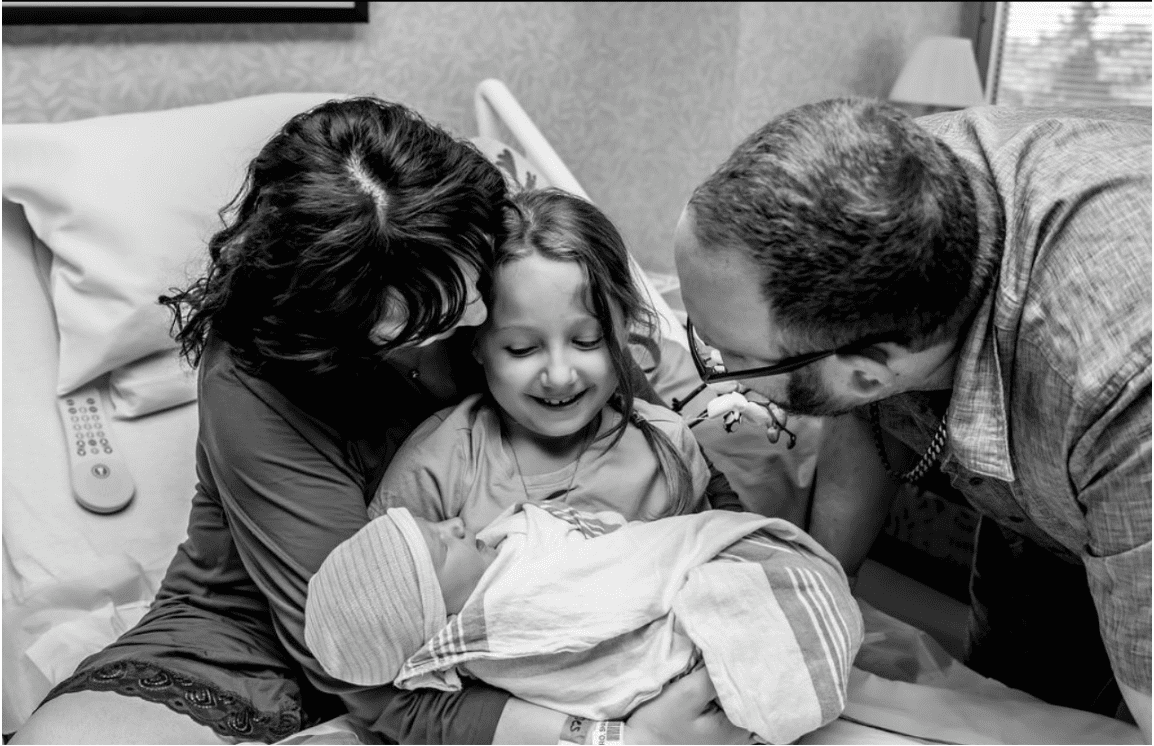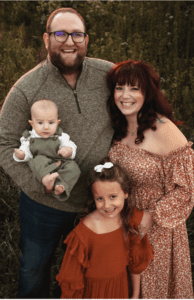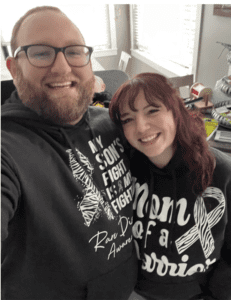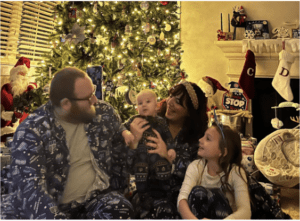Casey from Illinois

In September of 2022, the Shapiro family grew by one when we found out we were pregnant with our son, Casey. Our seven-year-old daughter, Lillian, was so excited to find out she had a baby brother on the way. Our family did all we could to prepare for our new baby, including genetic testing. We decided to see a geneticist because Casey’s maternal grandmother and mom have severe anemia, to the point where mom had 11 iron infusions throughout pregnancy. All of our test results came back “normal”, so we thought we had nothing to fear.
We welcomed Casey into the world on a beautiful, hot spring day in May 2023. Our delivery was smooth, and he latched instantly! Casey’s newborn screening came back with flying colors, other than some minor jaundice at the time. The same thing happened with our daughter, so we were not alarmed. We were discharged from the hospital after only one night.
The summer kicked off with an active, healthy, breastfed baby that loved to smile, coo and be on his tummy. We played every day, traveled, camped under the stars and went to concerts. Our boy was hitting milestones and doing something new every day. As a stay-at-home mom and a dad who works from home, we relished watching Casey grow.
In August we started noticing signs of regression. Our three-month-old baby wasn't moving during tummy time, stopped tracking faces, hands or toys. By September he was fighting to stay awake, and his muscle tone had diminished. The jaundice had increased, and Casey was yellow all over. Our family doctor seemed positive it was a response to an ear infection. Little did we know, this was the start of Casey's illness.
When there was no sign of progress, we called our local hospital. Immediately the nurse said, “Drop everything and call 911.” My husband was calm but felt the urgency like the operator did, whereas I was still thinking this was due to the ear infection. Next thing we knew, we were in the back of an ambulance heading to Ann & Robert H. Lurie Children’s Hospital of Chicago. I kept thinking, he has an ear infection, he's feeling the effects of medication, we will be right back home. After two blood transfusions and a diagnosis of genetic anemia (that would later be discovered to be due to his Cobalamin), we came back home after a week-long stay in the hospital. At this point we thought the worst was over. However, four days later Casey began to decline again. He was losing weight and his family doctor deemed him “failure to thrive”.

In the month of October, we spent 20 consecutive days living on that gray couch in the hospital. It was during this stay where we experienced more trauma than words can describe. We learned Casey had a brain bleed that had started in September. He was placed on an NG tube, and it wasn’t until after every blood test, body scan, ultrasound, and X-ray was performed that we received a confirmed diagnosis of Cobalamin C Disorder (CblC).
 We could barely process what any of this meant. We had more questions than we had answers. While CblC was explained to us, I kept hearing my husband's voice saying, “We are built for this”, while at the same time hearing the team of doctors saying, “this can cause seizures, blindness, heart attack and strokes”. We could barely wrap our heads around what we were up against. We will never forget looking at Casey laying in wires from his EKG, pulseOX, and NG tube and seeing him smile at us. The doctors said, “Casey is so lucky to have you both as parents.” Suddenly our world shifted, and we prepared to fight alongside Casey and his lifelong disease.
We could barely process what any of this meant. We had more questions than we had answers. While CblC was explained to us, I kept hearing my husband's voice saying, “We are built for this”, while at the same time hearing the team of doctors saying, “this can cause seizures, blindness, heart attack and strokes”. We could barely wrap our heads around what we were up against. We will never forget looking at Casey laying in wires from his EKG, pulseOX, and NG tube and seeing him smile at us. The doctors said, “Casey is so lucky to have you both as parents.” Suddenly our world shifted, and we prepared to fight alongside Casey and his lifelong disease.
The first concern from his care team was his beautiful blue eyes. CblC can cause Macular Degeneration and loss of vision. Thankfully, as of now, his eyes are in great shape. His brain and heart were next. Doctors determined his brain bleed was caused by pressure on his nerves, and luckily, he didn't need brain surgery. As for his heart, his EKG came back within the normal range as well. As testing continued and results came back positively, we still had millions of questions. We were still in shock, fighting sleep deprivation, breast pumping every two hours, and missing our daughter back home.
As our stay in the hospital continued, my husband and I learned how to drop an NG tube. We watched cameras go down into our son's body, and we learned to give injections from Casey's care team. We also learned how to grind medication and use IV poles to administer breast milk through this tube, all while still functioning on no sleep and continuing to be the best versions of ourselves. Looking back at it now, the time went by quickly, and we are so thankful for that. However, when we reflect on how we felt in the moment, the days felt like years.
When we returned home, all our family and friends rallied around us. They showed support with food deliveries, gift cards, care packages, visits, and lots of hugs and words of encouragement. Casey was still on his NG tube, and we started nightly injections, daily medications, and physical therapy once a week. We made a chart to keep track of medications and the phone didn’t stop ringing for appointments. The one we looked forward to the most was Casey’s final swallow study so he could come off the NG tube. After three weeks at home, Casey was off the NG and after two months at home he was coming back to baseline and his care team was shrinking. We started to see a new version of him. He started to hit his milestones again. He was rolling, picking up his head, reaching for toys, laughing, and becoming more playful each day! We had finally settled into our new routine and began to feel confident in our abilities to tackle CblC.
food deliveries, gift cards, care packages, visits, and lots of hugs and words of encouragement. Casey was still on his NG tube, and we started nightly injections, daily medications, and physical therapy once a week. We made a chart to keep track of medications and the phone didn’t stop ringing for appointments. The one we looked forward to the most was Casey’s final swallow study so he could come off the NG tube. After three weeks at home, Casey was off the NG and after two months at home he was coming back to baseline and his care team was shrinking. We started to see a new version of him. He started to hit his milestones again. He was rolling, picking up his head, reaching for toys, laughing, and becoming more playful each day! We had finally settled into our new routine and began to feel confident in our abilities to tackle CblC.
However, another battle was around the corner once cold and flu season hit. CblC symptoms can present when the immune system is compromised. In December Casey contracted a common cold and began to have seizures. We were back in the hospital and Casey had his first EEG. This time, we worked as a well-oiled machine to aid Casey with his new diagnosis of epilepsy, which is another potential symptom caused by CblC. After four more EEGs we have stabilized the seizures with medication.
Casey is now eight months old. He is getting stronger every day, and as parents, we are trying not to overanalyze every move he makes. With a rare diagnosis such as this, it can feel like you constantly live in a place of fight or flight. We are flooded with worries like: “When is the next hospital stay?”; “Is he having another seizure?”; and “Are we doing enough?”.
Thankfully, we have connected with other families in our rare disease community. We have found a lot of peace in reading other Hero Stories. We are always learning about Cobalamin Disorder and have immense gratitude for Casey’s entire care team. We love to see the excitement and joy in doctors' faces when they see Casey for a follow-up and he's gained weight, continues to do new things, and has hit new milestones! We are so proud!
 My husband and I continue to care for Casey at home. He still receives daily shots and oral medications that are projected to continue for the rest of his life, or until research tells us otherwise. It's hard to predict where Casey will be in five years, but we are hopeful that he will one day attend public school with minimal impacts from CblC. Our biggest concerns are navigating him not getting sick and preventing what we call “CblC flare-ups”.
My husband and I continue to care for Casey at home. He still receives daily shots and oral medications that are projected to continue for the rest of his life, or until research tells us otherwise. It's hard to predict where Casey will be in five years, but we are hopeful that he will one day attend public school with minimal impacts from CblC. Our biggest concerns are navigating him not getting sick and preventing what we call “CblC flare-ups”.
Currently, Casey will sleep through his injections, and we are thankful for that. We have learned creative ways to give injections from other families with older children. However, we can never think too far into the future as we don’t know where his CblC journey will take him.
Casey Marshall Shapiro is the bravest boy we know. He is loved, supported, and now all we can do is be HOPEFUL that we find a cure. We appreciate our family and friends who have taken the time to learn about his disease and check in with us. A lot of our family members have embraced the zebra ribbon to support Casey's rare disease diagnosis. It is important to continue to spread education, to keep the curiosity momentum going, and to encourage science to find a cure. We are thankful for the resources from Casey's care team who have mentally and emotionally cared for our family through this battle.
We were scared to share Casey's story because we felt so alone. Slowly, we started to connect with other families, members of our community who offered resources, and friends who were willing to drop off a crock pot of our favorite meals. We started to feel less alone, and more seen.
 If we had to give advice to a new member of the HCU/CblC family, we would say to give yourself grace. This diagnosis can be shocking, but you're not alone. Take each day one step at a time, speak with your care teams, seek therapy, connect with other families, and SPEAK OUT on social media. Turn inward to your family, don't be afraid to cry, or send questions to your doctor on MyChart at 3 am. Remind yourself that while this is life-changing and you may need to adjust your plans, you can still go out and see the world and enjoy life. Even when in survival mode, look for the good. No amount of answers will take away the feelings you may have to want to control this. ACCEPTANCE IS KEY! For injections, find the band-aids that make you laugh. Call your EEG a “fun ponytail”, search for the best vending machines in the hospitals, and learn to laugh again. Your family will get through this. There is a community out there, and if you’re reading this, you've found it.
If we had to give advice to a new member of the HCU/CblC family, we would say to give yourself grace. This diagnosis can be shocking, but you're not alone. Take each day one step at a time, speak with your care teams, seek therapy, connect with other families, and SPEAK OUT on social media. Turn inward to your family, don't be afraid to cry, or send questions to your doctor on MyChart at 3 am. Remind yourself that while this is life-changing and you may need to adjust your plans, you can still go out and see the world and enjoy life. Even when in survival mode, look for the good. No amount of answers will take away the feelings you may have to want to control this. ACCEPTANCE IS KEY! For injections, find the band-aids that make you laugh. Call your EEG a “fun ponytail”, search for the best vending machines in the hospitals, and learn to laugh again. Your family will get through this. There is a community out there, and if you’re reading this, you've found it.
